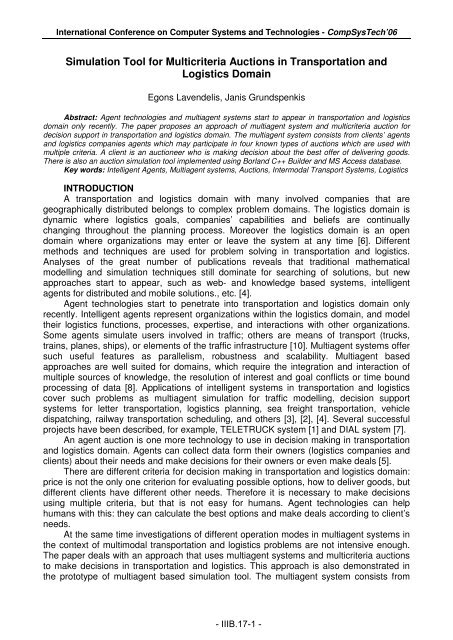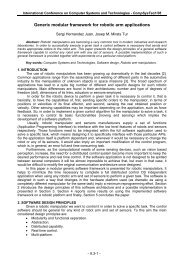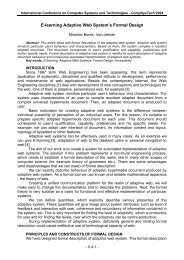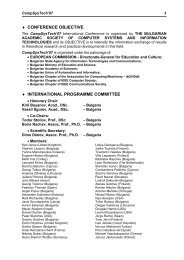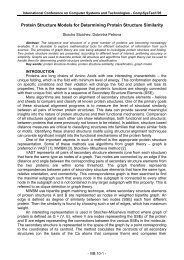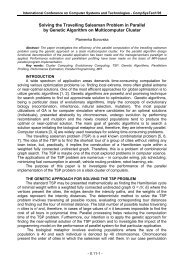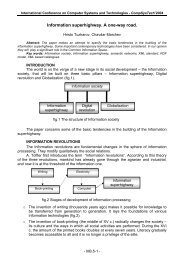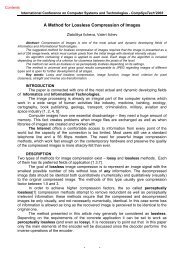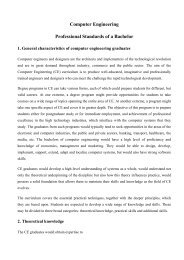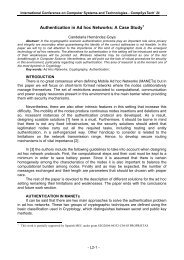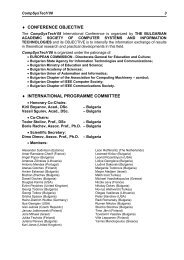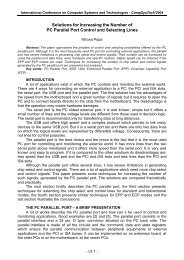Simulation Tool for Multicriteria Auctions in Transportation and ... - Ecet
Simulation Tool for Multicriteria Auctions in Transportation and ... - Ecet
Simulation Tool for Multicriteria Auctions in Transportation and ... - Ecet
You also want an ePaper? Increase the reach of your titles
YUMPU automatically turns print PDFs into web optimized ePapers that Google loves.
International Conference on Computer Systems <strong>and</strong> Technologies - CompSysTech’06<strong>Simulation</strong> <strong>Tool</strong> <strong>for</strong> <strong>Multicriteria</strong> <strong>Auctions</strong> <strong>in</strong> <strong>Transportation</strong> <strong>and</strong>Logistics Doma<strong>in</strong>Egons Lavendelis, Janis GrundspenkisAbstract: Agent technologies <strong>and</strong> multiagent systems start to appear <strong>in</strong> transportation <strong>and</strong> logisticsdoma<strong>in</strong> only recently. The paper proposes an approach of multiagent system <strong>and</strong> multicriteria auction <strong>for</strong>decision support <strong>in</strong> transportation <strong>and</strong> logistics doma<strong>in</strong>. The multiagent system consists from clients’ agents<strong>and</strong> logistics companies agents which may participate <strong>in</strong> four known types of auctions which are used withmultiple criteria. A client is an auctioneer who is mak<strong>in</strong>g decision about the best offer of deliver<strong>in</strong>g goods.There is also an auction simulation tool implemented us<strong>in</strong>g Borl<strong>and</strong> C++ Builder <strong>and</strong> MS Access database.Key words: Intelligent Agents, Multiagent systems, <strong>Auctions</strong>, Intermodal Transport Systems, LogisticsINTRODUCTIONA transportation <strong>and</strong> logistics doma<strong>in</strong> with many <strong>in</strong>volved companies that aregeographically distributed belongs to complex problem doma<strong>in</strong>s. The logistics doma<strong>in</strong> isdynamic where logistics goals, companies’ capabilities <strong>and</strong> beliefs are cont<strong>in</strong>uallychang<strong>in</strong>g throughout the plann<strong>in</strong>g process. Moreover the logistics doma<strong>in</strong> is an opendoma<strong>in</strong> where organizations may enter or leave the system at any time [6]. Differentmethods <strong>and</strong> techniques are used <strong>for</strong> problem solv<strong>in</strong>g <strong>in</strong> transportation <strong>and</strong> logistics.Analyses of the great number of publications reveals that traditional mathematicalmodell<strong>in</strong>g <strong>and</strong> simulation techniques still dom<strong>in</strong>ate <strong>for</strong> search<strong>in</strong>g of solutions, but newapproaches start to appear, such as web- <strong>and</strong> knowledge based systems, <strong>in</strong>telligentagents <strong>for</strong> distributed <strong>and</strong> mobile solutions., etc. [4].Agent technologies start to penetrate <strong>in</strong>to transportation <strong>and</strong> logistics doma<strong>in</strong> onlyrecently. Intelligent agents represent organizations with<strong>in</strong> the logistics doma<strong>in</strong>, <strong>and</strong> modeltheir logistics functions, processes, expertise, <strong>and</strong> <strong>in</strong>teractions with other organizations.Some agents simulate users <strong>in</strong>volved <strong>in</strong> traffic; others are means of transport (trucks,tra<strong>in</strong>s, planes, ships), or elements of the traffic <strong>in</strong>frastructure [10]. Multiagent systems offersuch useful features as parallelism, robustness <strong>and</strong> scalability. Multiagent basedapproaches are well suited <strong>for</strong> doma<strong>in</strong>s, which require the <strong>in</strong>tegration <strong>and</strong> <strong>in</strong>teraction ofmultiple sources of knowledge, the resolution of <strong>in</strong>terest <strong>and</strong> goal conflicts or time boundprocess<strong>in</strong>g of data [8]. Applications of <strong>in</strong>telligent systems <strong>in</strong> transportation <strong>and</strong> logisticscover such problems as multiagent simulation <strong>for</strong> traffic modell<strong>in</strong>g, decision supportsystems <strong>for</strong> letter transportation, logistics plann<strong>in</strong>g, sea freight transportation, vehicledispatch<strong>in</strong>g, railway transportation schedul<strong>in</strong>g, <strong>and</strong> others [3], [2], [4]. Several successfulprojects have been described, <strong>for</strong> example, TELETRUCK system [1] <strong>and</strong> DIAL system [7].An agent auction is one more technology to use <strong>in</strong> decision mak<strong>in</strong>g <strong>in</strong> transportation<strong>and</strong> logistics doma<strong>in</strong>. Agents can collect data <strong>for</strong>m their owners (logistics companies <strong>and</strong>clients) about their needs <strong>and</strong> make decisions <strong>for</strong> their owners or even make deals [5].There are different criteria <strong>for</strong> decision mak<strong>in</strong>g <strong>in</strong> transportation <strong>and</strong> logistics doma<strong>in</strong>:price is not the only one criterion <strong>for</strong> evaluat<strong>in</strong>g possible options, how to deliver goods, butdifferent clients have different other needs. There<strong>for</strong>e it is necessary to make decisionsus<strong>in</strong>g multiple criteria, but that is not easy <strong>for</strong> humans. Agent technologies can helphumans with this: they can calculate the best options <strong>and</strong> make deals accord<strong>in</strong>g to client’sneeds.At the same time <strong>in</strong>vestigations of different operation modes <strong>in</strong> multiagent systems <strong>in</strong>the context of multimodal transportation <strong>and</strong> logistics problems are not <strong>in</strong>tensive enough.The paper deals with an approach that uses multiagent systems <strong>and</strong> multicriteria auctionsto make decisions <strong>in</strong> transportation <strong>and</strong> logistics. This approach is also demonstrated <strong>in</strong>the prototype of multiagent based simulation tool. The multiagent system consists from- IIIB.17-1 -
International Conference on Computer Systems <strong>and</strong> Technologies - CompSysTech’06clients’ agents <strong>and</strong> logistic companies agents which allow simulat<strong>in</strong>g four different types ofauctions. These auctions are organized not by only one criterion, but there are up to sixdifferent criteria implemented. At the end of the auction the client can make a deal with thew<strong>in</strong>n<strong>in</strong>g agent.EXAMPLE OF THE MULTIMODAL TRANSPORTATION ROUTEOne very significant cargo flow is from Asia to Europe <strong>and</strong> one way how to delivergoods from Asia to Europe is by us<strong>in</strong>g the follow<strong>in</strong>g supply cha<strong>in</strong>: “Asian Deep Sea Port ↔Western Europe Deep Sea Port ↔ Baltic <strong>and</strong> Mediterranean feeder ports ↔ RailwayConta<strong>in</strong>er Term<strong>in</strong>als ↔ European Costumers”. One example is shown <strong>in</strong> Figure 1. [5] Wewill use this cha<strong>in</strong> as an example to show basic concepts of multiagent systems <strong>for</strong>select<strong>in</strong>g the best company <strong>and</strong> route <strong>for</strong> transport<strong>in</strong>g goods.Fig. 1. Example of supply cha<strong>in</strong>MULTIAGENT SYSTEMS AND AUCTIONSIn this paper we discuss the possibility to simulate cooperation between all <strong>in</strong>terestedparties: carriers, clients (owners of goods) <strong>and</strong> logistics companies. Clients do not directlycooperate with carriers, but through logistics companies. We discuss only communicationsbetween clients <strong>and</strong> logistics companies: they will have agents with<strong>in</strong> multiagent system; itconsists of one client’s agent (auctioneer <strong>in</strong> auction) <strong>and</strong> several logistics companies’agents. [10] Clients agent has <strong>in</strong><strong>for</strong>mation about clients needs <strong>and</strong> starts an auctionaccord<strong>in</strong>g to this <strong>in</strong><strong>for</strong>mation. Then each logistics companies’ agent calculates his privatevaluation: all criterion values <strong>in</strong> the best possible route which also is calculated us<strong>in</strong>g allcriteria. Then agent will make a bid accord<strong>in</strong>g to its strategy <strong>in</strong> particular type of auction. Inthis paper we use four different types of auctions [9]:• English auctions (the most commonly known type of auction) that are first-price, opencry, ascend<strong>in</strong>g auctions. The auctioneer starts off by suggest<strong>in</strong>g a reservation price. Ifno agent (bidder) is will<strong>in</strong>g to bid more than the reservation price, the good is allocatedto auctioneer <strong>for</strong> this amount. In other case, bids are then <strong>in</strong>vited from agents who mustbid more than current highest bid, <strong>and</strong> then the w<strong>in</strong>ner is agent who has made thecurrent highest bid. In English auctions dom<strong>in</strong>ant strategy is to bid a small amount morethan the current price, if it is less than private valuation.• Dutch auctions are open-cry descend<strong>in</strong>g auctions. The auctioneer starts out by offer<strong>in</strong>gsome artificially high price. The auctioneer then cont<strong>in</strong>ually lower the current price by- IIIB.17-2 -
International Conference on Computer Systems <strong>and</strong> Technologies - CompSysTech’06some small value until some agent makes a bid <strong>and</strong> w<strong>in</strong>s the auction. There is nodom<strong>in</strong>ant strategy <strong>for</strong> Dutch auctions <strong>in</strong> general.• First-price sealed-bid auction is an example of one shot auction. There is a s<strong>in</strong>gle round<strong>in</strong> which bidders submit to the auctioneer a bid. The w<strong>in</strong>ner is an agent that made thehighest bid. Agents use the dom<strong>in</strong>ant strategy – to bid a bit less than true valuation.• Vickrey auctions are the most unusual <strong>and</strong> perhaps counter<strong>in</strong>tuitive of all consideredauction types because these auctions are second price sealed-bid auctions. There is as<strong>in</strong>gle negotiation round, dur<strong>in</strong>g which each bidder submits a s<strong>in</strong>gle bid; bidders do notget to see the bids made by other agents. The w<strong>in</strong>ner is an agent who made the highestbid, however he pays the price of the second highest bid. Agents use the dom<strong>in</strong>antstrategy – to bid his true valuation. This is the ma<strong>in</strong> advantage of this protocol <strong>for</strong> theauctioneer.CRITERIA FOR DECISION MAKINGTraditionally auctions are made us<strong>in</strong>g only one description of a bid: the price. But <strong>in</strong>transportation there are many criteria to take <strong>in</strong>to consideration <strong>in</strong> different cases. Thesecriteria are of different nature <strong>and</strong> there<strong>for</strong>e need different approaches. In this paper wewill use the follow<strong>in</strong>g classification:• Criteria can be characteristics of route or logistics company. The first ones vary <strong>in</strong>different routes of the same company, the second ones – do not.• Logistics companies’ characteristics can be objective or subjective. Objectivecriteria are facts about the company <strong>and</strong> are known <strong>for</strong> everybody, but subjectivecriteria are known only by clients (usually from previous experience).• There are criteria that have their natural measurements (price, time), but there arealso such criteria which do not (staff qualification).• Criteria can have discrete, cont<strong>in</strong>uous or Boolean scale.These different criterion classes also need different approach dur<strong>in</strong>g the auctions; thesedifferences will be discussed <strong>in</strong> next chapter.MULTICRITERIA AUCTION<strong>Multicriteria</strong> auction is an auction which uses multiple criteria <strong>for</strong> bid evaluation. It isdone by calculat<strong>in</strong>g some evaluation from all criteria. For this purpose it is also neededthat user <strong>in</strong>puts weights <strong>for</strong> each criterion. Then each bid can be evaluated us<strong>in</strong>g equation1.V =n∑wi* v ii=1 , where (1)V – evaluation;n – criterion count;w i – i th weight;v i – i th criterion value.To use equation 1 it is necessary not only to receive weights from user, but also allcriterion values from a bidder. But not all criteria are known <strong>for</strong> an agent: it does not knowsubjective ones. Thus, bidder <strong>in</strong>cludes <strong>in</strong> its bid only known part of value, but auctioneeradds unknown (to bidder) one. Consider<strong>in</strong>g that known criteria are the first ones, known<strong>and</strong> unknown parts can be calculated us<strong>in</strong>g equations 2 <strong>and</strong> 3.knn∑V w * v(2)= kni=1n∑i=ni+ 1iV = w * v , where (3)unknV kn – known part of evaluation;n k – criterion count <strong>for</strong> known part;w i – i th weight.kiiV unkn – unknown part of evaluation;n – total criterion count;- IIIB.17-3 -
International Conference on Computer Systems <strong>and</strong> Technologies - CompSysTech’06Next question is how bidders can calculate how much to bid. Agent needs some <strong>in</strong>put<strong>for</strong>m an auctioneer. In sealed-bid auctions bidders need to know only start<strong>in</strong>g po<strong>in</strong>tdest<strong>in</strong>ation <strong>and</strong> weights – bidders do not receive any <strong>in</strong><strong>for</strong>mation about other bids.It is different <strong>in</strong> open-cry auctions: agents need to know the best offer to overbid it,but it will calculate only the known part. That means its <strong>in</strong>put must be the needed knownpart. It can be calculated us<strong>in</strong>g equation 4.maxIn = V − V , where (4)unknIn – agents <strong>in</strong>put; V max – maximal bid; V unkn – needed unknown part.When agent receives its <strong>in</strong>put, the first th<strong>in</strong>g it does is to calculate his privateevaluation of it. It can be done <strong>in</strong>terpret<strong>in</strong>g term<strong>in</strong>als <strong>and</strong> routes between them as a graph<strong>and</strong> use search algorithms [5]. Then if an agent decides to make a bid accord<strong>in</strong>g to itsstrategy, it needs to calculate what price to <strong>in</strong>clude <strong>in</strong> a bid to have the bid with wantedevaluation. Assum<strong>in</strong>g that price is the first criterion, it can be done us<strong>in</strong>g equation 5.vn kbidVkn− ∑ wi* vii=21= , where (5)w1bidv 1 – first criterion (price);Vkn– known part <strong>for</strong> wanted bid;n k – criterion count <strong>for</strong> known part; w i – i th weight;v i – i th criterion value;w 1 – weight <strong>for</strong> price.This method states one limitation: the weight <strong>for</strong> price is not 0 – auction can not bewithout price as criterion. But this limit is also logical: price is the only one criterion thatbidder can freely change. If there will be no criteria to change, it will not be possible <strong>for</strong>bidders to bid what they want <strong>and</strong> there<strong>for</strong>e auction to take place.Equations 1 till 5 are needed to migrate from s<strong>in</strong>gle criterion auction to multicriteriaone. The other consideration is users view. How can user who usually is a bus<strong>in</strong>essm<strong>and</strong>eterm<strong>in</strong>e what weights to use? One possible solution is to state that weight <strong>for</strong> price is 1.Then all other weights will be prices per unit of this criterion. And this language is wellunderstood by bus<strong>in</strong>ess people. That means user has to enter only weights (prices per unitof criterion) <strong>and</strong> start<strong>in</strong>g values of criteria (only <strong>in</strong> open-cry auctions). This solution is used<strong>in</strong> the implemented simulation tool.DEVELOPED SIMULATION TOOL FOR MULTICRITERIA AUCTIONThe first th<strong>in</strong>g to do to implement this tool is to choose some criteria to implement.Real life problem can have 20-30 or even more criteria, but <strong>for</strong> simulation tool the ma<strong>in</strong>th<strong>in</strong>g is to <strong>in</strong>clude all k<strong>in</strong>ds of criteria (both route criteria <strong>and</strong> logistics companies’ criteria,both objective <strong>and</strong> subjective criteria, etc.). Table 1 shows selected criteria <strong>for</strong>implementation <strong>and</strong> their characteristics.Table 1. Selected criteriaN Criterion Orig<strong>in</strong> Objectivity Measurement units Scale1 Price Route Natural (money units) Cont<strong>in</strong>uous2 Total delivery time Route Natural (hours) Cont<strong>in</strong>uous3 Cargo safety Route Natural (%) Cont<strong>in</strong>uous4 Monitor<strong>in</strong>g possibility Company’s Objective Natural (Yes/No) Boolean5 Reliability Company’s Subjective Artificial (0-10) Discrete6 Staff qualification Company’s Subjective Artificial (0-10) DiscreteThese criteria are used to make evaluation <strong>in</strong> the simulation tool which isimplemented us<strong>in</strong>g Borl<strong>and</strong> C++ Builder <strong>and</strong> MS Access database. The simulation toolonly shows the mechanism how these auctions can be carried out. At the moment thereare big differences from real deal mak<strong>in</strong>g system. First, our system runs on one computer- IIIB.17-4 -
International Conference on Computer Systems <strong>and</strong> Technologies - CompSysTech’06<strong>and</strong> it is not possible to connect to it through Internet. Second, our system has commondatabase <strong>for</strong> agents. Agents get from it only their knowledge def<strong>in</strong>ed by relationships <strong>in</strong>this database. At the same time, it is needed to stress that these differences are onlytechnical realization details, <strong>and</strong> they do not affect the auction algorithms <strong>and</strong> ideas. Thatis only a matter of programm<strong>in</strong>g client server applications to implement a real system.User has to <strong>in</strong>put weights <strong>and</strong> start<strong>in</strong>g values <strong>for</strong> each criterion <strong>in</strong>to auction parameter<strong>for</strong>m to start an auction by press<strong>in</strong>g button “Star Auction” <strong>and</strong> get every next bid bypress<strong>in</strong>g “Next bid”. <strong>Tool</strong>’s ma<strong>in</strong> w<strong>in</strong>dow with first bid <strong>for</strong> route Shanghai - Liepaja is shown<strong>in</strong> figure 2. It also supports knowledge base edit<strong>in</strong>g <strong>in</strong> simple database edit<strong>in</strong>g <strong>for</strong>ms: usercan edit all possible lists (logistics companies, schedule, etc). This part is shown <strong>in</strong> theright part of figure 2 (buttons are disabled dur<strong>in</strong>g the auction). All <strong>for</strong>ms are not shown.Figure 3. Bid visualisationCONCLUSIONS AND FUTURE WORKThe developed simulation tool demonstrates that it is quite simple to implement amultiagent system <strong>for</strong> automation of communication between clients <strong>and</strong> logisticscompanies. The deal may be made us<strong>in</strong>g different types of auctions; these auctions canbe multicriteria auctions, what means that it is possible to f<strong>in</strong>d the best way to delivergoods <strong>for</strong> clients not only by price but also by other criteria. That m<strong>in</strong>imizes ef<strong>for</strong>ts <strong>for</strong>f<strong>in</strong>d<strong>in</strong>g the best way to deliver some goods: the client <strong>in</strong>stead of contact<strong>in</strong>g all knownlogistic companies <strong>and</strong> mak<strong>in</strong>g complex multicriteria decisions can just enter his wills <strong>and</strong><strong>in</strong> few moments get deal with one company. Logistic companies, <strong>in</strong> their turn, need not tomake negotiations with all clients, they can just announce their company’s politics tocorrespond<strong>in</strong>g agents <strong>and</strong> these agents will make deals with possible clients.There is no significant difference between implement<strong>in</strong>g one criterion auction ormulticriteria one. <strong>Multicriteria</strong> auction just <strong>in</strong>volves some extra calculations, but they arenot too complicated. From users viewpo<strong>in</strong>t the changes are a bit more significant: first ofall, user can f<strong>in</strong>d best offer by multiple criteria, the second one, user has to enter more<strong>in</strong>put data, but this <strong>in</strong>put is maximally simplified. The third is that user gets more dataabout the offer: all criterion values. And also it is worth mention<strong>in</strong>g that user may getconfused if current offer get more expensive than the previous one: it is because othercriteria have better values <strong>and</strong> total evaluation is there<strong>for</strong>e better.- IIIB.17-5 -
International Conference on Computer Systems <strong>and</strong> Technologies - CompSysTech’06It is possible to <strong>in</strong>clude <strong>in</strong> this system also carriers <strong>and</strong> automate their communicationwith logistic companies. This is one of the directions of future work. Then it will be a multimulti-agentsystem <strong>and</strong> each logistic company <strong>and</strong> carriers with which it cooperates makea holon. For client this holon is represented by a logistic companies agent.Multiagent system is advanced <strong>and</strong> quite cheap solution <strong>for</strong> communication problemsolv<strong>in</strong>g between logistic company <strong>and</strong> their clients, <strong>and</strong> also carriers.The future work is to make our systems more realistic. There are no big difficulties toimplement a real deal mak<strong>in</strong>g system. That is only a matter of programm<strong>in</strong>g of clientserver mechanisms, because all complicated algorithms are already implemented <strong>in</strong> thedeveloped simulation tool. It is also possible to make these auctions a legal <strong>in</strong>strument byus<strong>in</strong>g electronic signatures. In this case all deals should be made onl<strong>in</strong>e <strong>and</strong> a lot ofhuman resources should be saved.REFERENCES1. Bürckert H.-J., Fischer K., Vierke, G: Holonic Fleet Schedull<strong>in</strong>g with TELETRUCK.In: Proceed<strong>in</strong>gs of the Second International Conference on Comput<strong>in</strong>g AntipatorySystems. (CASYS’98) (1998)2. Funk P., Vierke, G., Bürckert H.-J.: Distributed Intermodal <strong>Transportation</strong> Plann<strong>in</strong>ngIn: Multiagentensysteme <strong>in</strong> der Transportlogistic (1999) (available atwww.agki.tzi.de/ki99-mas/funk_etal_99.pdf)3. Gambardella, L. M. et al.: The Use of <strong>Simulation</strong> <strong>in</strong> the Socio-EconomicalEvaluation of the Intermodal Term<strong>in</strong>al. HMS 2000, Maritime & Industrial LogisticsModell<strong>in</strong>g <strong>and</strong> <strong>Simulation</strong>, Portof<strong>in</strong>o, Italy (2000) (available atwww.idsia.ch/~luca/hms2000.pdf)4. Graud<strong>in</strong>a V., Grundspenkis J., Technologies <strong>and</strong> Multi-Agent System Architectures<strong>for</strong> <strong>Transportation</strong> <strong>and</strong> Logistics Support: An Overview. In: Proceed<strong>in</strong>gs of theInternational Conference on Computer Systems <strong>and</strong> Technologies –CompSysTech’05, Varna, Bulgaria, June 16, 17, 2005, The Bulgarian Chapter ofACM, Bulgaria (2005)5. Grundspenkis, J., Lavendelis, E. “Multiagent Based <strong>Simulation</strong> <strong>Tool</strong> <strong>for</strong><strong>Transportation</strong> <strong>and</strong> Logistics Decision Support” In: Proceed<strong>in</strong>gs of the 3 rdInternational Workshop on Computer Supported Activity Coord<strong>in</strong>ation – CSAC2006, Cyprus, Paphos, May 20066. Perug<strong>in</strong>i, D. et al. Agents <strong>in</strong> Logistics Plann<strong>in</strong>g – Experiences with the CoalitionAgents Experiment Project. In: Proceed<strong>in</strong>gs of Workshop at the SecondInternational Jo<strong>in</strong>t Conference on Autonomous Agents <strong>and</strong> Multiagent Systems(AAMAS 2003), Melbourne, Australia, July (2003)7. Satapathy, G., Kumara, S., R., T., Moore, L. M.: Distributed Intelligent Agents <strong>for</strong>Logistics (DIAL). Journal of Expert Systems Applications <strong>and</strong> Practice (1998)8. Weiss, G.: Adaptation <strong>in</strong> Learn<strong>in</strong>g <strong>in</strong> Multi-Agent Systems: Some Remarks <strong>and</strong> aBibliography. In: Proceed<strong>in</strong>gs of the IJCAI ’95 Workshop on Adaptation <strong>and</strong>Learn<strong>in</strong>g <strong>in</strong> Multi-Agent Systems. LNAI 1042, Spr<strong>in</strong>ger (1995)9. Wooldbridge, M.: An <strong>in</strong>troduction to Multiagent Systems. John Wiley & Sons,Baff<strong>in</strong>s Lane, Chichester, Engl<strong>and</strong> (2002), 348 p.10. Zhu, L. M., Bos, A.: Agent-Based Design of Intermodal Freight <strong>Transportation</strong>Systems. NECTAR Conference, Deeft, The Netherl<strong>and</strong>s (1999)ABOUT THE AUTHORSAssistant researcher Egons Lavendelis, B. Sc.<strong>in</strong>g, Department of Systems Theory<strong>and</strong> Design, Riga Technical University, Phone: +371 29876891, Е-mail: egolav@<strong>in</strong>box.lv.Prof. Janis Grundspenkis, Dr. Habil. Sc.<strong>in</strong>g., Department of Systems Theory <strong>and</strong>Design, Riga Technical University, Phone: +371 7089581, e-mail: jgrun@cs.rtu.lv.- IIIB.17-6 -


